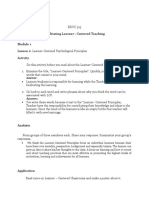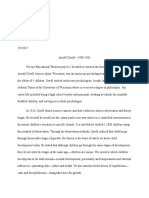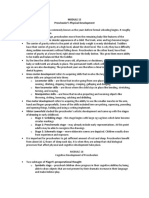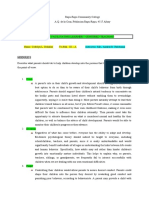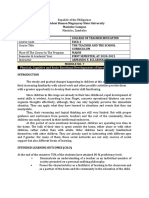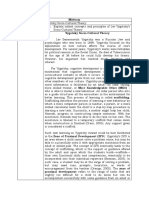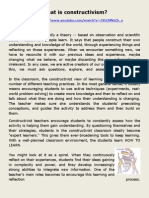Bruner's Theory of Constructivism
Bruner's Theory of Constructivism
Uploaded by
Megi Ardji AnandaCopyright:
Available Formats
Bruner's Theory of Constructivism
Bruner's Theory of Constructivism
Uploaded by
Megi Ardji AnandaOriginal Title
Copyright
Available Formats
Share this document
Did you find this document useful?
Is this content inappropriate?
Copyright:
Available Formats
Bruner's Theory of Constructivism
Bruner's Theory of Constructivism
Uploaded by
Megi Ardji AnandaCopyright:
Available Formats
Bruner's Theory of Constructivism
The outcome of cognitive development is thinking. The intelligent mind creates from experience
"generic coding systems that permit one to go beyond the data to new and possibly fruitful
predictions" (Bruner, 1957, p. 234).
Thus, children as they grow must acquire a way of representing the "recurrent regularities" in their
environment.
So, to Bruner, important outcomes of learning include not just the concepts, categories, and
problem-solving procedures invented previously by the culture, but also the ability to "invent"
these things for oneself.
Cognitive growth involves an interaction between basic human capabilities and "culturally
invented technologies that serve as amplifiers of these capabilities." These culturally invented
technologies include not just obvious things such as computers and television, but also more
abstract notions such as the way a culture categorizes phenomena, and language itself. Bruner
would likely agree with Vygotsky that language serves to mediate between environmental stimuli
and the individual's response.
The aim of education should be to create autonomous learners (i.e., learning to learn).
In his research on the cognitive development of children (1966), Jerome Bruner proposed
three modes of representation:
Enactive representation (action-based)
Iconic representation (image-based)
Symbolic representation (language-based)
Bruner's Three Modes of Representation
Modes of representation are the way in which information or knowledge are stored and encoded in
memory.
Rather than neat age related stages (like Piaget), the modes of representation are integrated and
only loosely sequential as they "translate" into each other.
Enactive
(0 - 1 years)
This appears first. It involves encoding action based information and storing it in our memory.
For example, in the form of movement as a muscle memory, a baby might remember the action of
shaking a rattle.
The child represents past events through motor responses, i.e. an infant will “shake a rattle” which
has just been removed or dropped, as if the movements themselves are expected to produce the
accustomed sound. And this is not just limited to children.
Many adults can perform a variety of motor tasks (typing, sewing a shirt, operating a lawn mower)
that they would find difficult to describe in iconic (picture) or symbolic (word) form.
By Saul McLeod- (Evaeducation.info)
Iconic
(1 - 6 years)
This is where information is stored visually in the form of images (a mental picture in the mind’s
eye). For some, this is conscious; others say they don’t experience it. This may explain why, when
we are learning a new subject, it is often helpful to have diagrams or illustrations to accompany
verbal information.
Symbolic
(7 years onwards)
This develops last. This is where information is stored in the form of a code or symbol, such as
language. This is the most adaptable form of representation, for actions & images have a fixed
relation to that which they represent. Dog is a symbolic representation of a single class.
Symbols are flexible in that they can be manipulated, ordered, classified etc., so the user isn’t
constrained by actions or images. In the symbolic stage, knowledge is stored primarily as words,
mathematical symbols, or in other symbol systems.
Bruner's constructivist theory suggests it is effective when faced with new material to follow a
progression from enactive to iconic to symbolic representation; this holds true even for adult
learners. A true instructional designer, Bruner's work also suggests that a learner even of a very
young age is capable of learning any material so long as the instruction is organized appropriately,
in sharp contrast to the beliefs of Piaget and other stage theorists.
The Importance of Language
Language is important for the increased ability to deal with abstract concepts. Bruner argues
that language can code stimuli and free an individual from the constraints of dealing only with
appearances, to provide a more complex yet flexible cognition.
The use of words can aid the development of the concepts they represent and can remove the
constraints of the “here & now” concept. Basically, he sees the infant as an intelligent & active
problem solver from birth, with intellectual abilities basically similar to those of the mature adult.
According to Bruner the child represents the world to himself in three different ways.
Educational Implications of Bruner’s Theory
For Bruner (1961), the purpose of education is not to impart knowledge, but instead to facilitate a
child's thinking and problem solving skills which can then be transferred to a range of situations.
Specifically, education should also develop symbolic thinking in children.
In 1960 Bruner's text, The Process of Education was published. The main premise of Bruner's
text was that students are active learners who construct their own knowledge.
Bruner (1960) opposed Piaget's notion of readiness. He argued that schools waste time trying to
match the complexity of subject material to a child's cognitive stage of development. This means
students are held back by teachers as certain topics are deemed to difficult to understand and must
be taught when the teacher believes the child has reached the appropriate state of cognitive
maturity.
Bruner (1960) adopts a different view and believes a child (of any age) is capable of
understanding complex information: 'We begin with the hypothesis that any subject can be taught
effectively in some intellectually honest form to any child at any stage of development'.
(p. 33)
By Saul McLeod- (Evaeducation.info)
Bruner (1960) explained how this was possible through the concept of the spiral curriculum.
This involved information being structured so that complex ideas can be taught at a simplified
level first, and then re-visited at more complex levels later on. Therefore, subjects would be taught
at levels of gradually increasing difficultly (hence the spiral analogy). Ideally teaching his way
should lead to children being able to solve problems by themselves.
Bruner (1961) proposes that learners’ construct their own knowledge and do this by organizing
and categorizing information using a coding system. Bruner believe that the most effect way to
develop a coding system is to discover it rather than being told it by the teacher. The concept of
discovery learning implies that students construct their own knowledge for themselves (also
known as a constructist approach).
The role of the teacher should not be to teach information by rote learning, but instead to facilitate
the learning process. This means that a good teacher will design lessons that help student discover
the relationship between bits of information. To do this a teacher must give students the
information they need, but without organizing for them. The use of the spiral curriculum can aid
the process of discovery learning.
Bruner and Vygotsky
Both Bruner and Vygotsky emphasise a child's environment, especially the social environment,
more than Piaget did. Both agree that adults should play an active role in assisting the child's
learning.
Bruner, like Vygotksy, emphasised the social nature of learning, citing that other people should
help a child develop skills through the process of scaffolding. The term scaffolding first appeared
in the literature when Wood, Bruner and Ross described how tutors' interacted with pre-schooler
to help them solve a block reconstruction problem (Wood et al., 1976).
The concept of scaffolding is very similar to Vygotsky's notion of the zone of proximal
development, and it not uncommon for the terms to be used interchangeably. Scaffolding involves
helpful, structured interaction between an adult and a child with the aim of helping the child
achieve a specific goal.
[Scaffolding] refers to the steps taken to reduce the degrees of freedom in carrying out some task
so that the child can concentrate on the difficult skill she is in the process of acquiring. (Bruner,
1978, p. 19)
Difference Between Bruner and Piaget
Obviously there are similarities between Piaget and Bruner, but an important difference is that
Bruner’s modes are not related in terms of which presuppose the one that precedes it. Whilst
sometimes one mode may dominate in usage, they co-exist. Bruner states that what determines the
level of intellectual development is the extent to which the child has been given appropriate
instruction together with practice or experience. So - the right way of presentation and the right
explanation will enable a child to grasp a concept usually only understood by an adult. His theory
stresses the role of education and the adult.
Although Bruner proposes stages of cognitive development, he doesn’t see them as representing
different separate modes of thought at different points of development (like Piaget). Instead, he
sees a gradual development of cognitive skills and techniques into more integrated “adult”
cognitive techniques.
By Saul McLeod- (Evaeducation.info)
Bruner views symbolic representation as crucial for cognitive development and since language is
our primary means of symbolizing the world, he attaches great importance to language in
determining cognitive development.
BRUNER AGREES WITH BRUNER DISAGREES WITH PIAGET
PIAGET
1. Children are PRE-ADAPTED to 1. Development is a CONTINUOUS PROCESS – not a
learning series of stages
2. Children have a NATURAL 2. The development of LANGUAGE is a cause not a
CURIOSITY consequence of cognitive development
3. Children’s COGNITIVE 3. You can SPEED-UP cognitive development. You don’t
STRUCTURES develop over time have to wait for the child to be ready
4. Children are ACTIVE participants 4. The involvement of ADULTS and MORE
in the learning process KNOWLEDGEABLE PEERS makes a big difference
5. Cognitive development entails the 5. Symbolic thought does NOT REPLACE EARLIER
acquisition of SYMBOLS MODES OF REPRESENTATION
References
Bruner, J. S. (1957). Going beyond the information given. New York: Norton.
Bruner, J. (1960). The Process of education. Cambridge, Mass.: Harvard University Press.
Bruner, J. S. (1961). The act of discovery. Harvard Educational Review, 31, 21-32.
Bruner, J. S. (1966). Toward a theory of instruction, Cambridge, Mass.: Belkapp Press.
Bruner, J. S. (1973). The relevance of education. New York: Norton.
Bruner, J. (1978). The role of dialogue in language acquisition. In A. Sinclair, R., J. Jarvelle, and
W. J. M. Levelt (eds.) The Child's Concept of Language. New York: Springer-Verlag.
Wood, D. J., Bruner, J. S., & Ross, G. (1976). The role of tutoring in problem solving. Journal of
Child Psychiatry and Psychology, 17(2), 89-100.
By Saul McLeod- (Evaeducation.info)
You might also like
- Metacognition: An Overview 20Document27 pagesMetacognition: An Overview 20Jeovic XDNo ratings yet
- Key Theories of Educational Psychology-Cristine AbudeDocument10 pagesKey Theories of Educational Psychology-Cristine AbudeRoessi Mae Abude AratNo ratings yet
- BrunerDocument13 pagesBrunerLauraNo ratings yet
- BrunerDocument7 pagesBrunerGiovanni MonticoloNo ratings yet
- Escara, Cristy T - Freud's Components of PersonalityDocument2 pagesEscara, Cristy T - Freud's Components of PersonalityCristy EscaraNo ratings yet
- Part 3-Module 9 Gestalt Psychology PDFDocument27 pagesPart 3-Module 9 Gestalt Psychology PDFSheena BarulanNo ratings yet
- Developmental Theories and Other Relevant TheoriesDocument6 pagesDevelopmental Theories and Other Relevant TheoriesMay ann AntonioNo ratings yet
- Chapter 4 Behavioral Learning TheoriesDocument2 pagesChapter 4 Behavioral Learning TheoriesJulie Soquiño100% (1)
- Module 8Document3 pagesModule 8Kel Lumawan100% (1)
- Teacher As FacilitatorDocument3 pagesTeacher As FacilitatorKristalyn MiguelNo ratings yet
- Module2bL - SPED.. YeaaahDocument5 pagesModule2bL - SPED.. YeaaahJane MinNo ratings yet
- Module 1 Lesson 1 PDFDocument5 pagesModule 1 Lesson 1 PDFJoy GeronaNo ratings yet
- Activity 3Document2 pagesActivity 3Theobelle RegidorNo ratings yet
- Facilitating Learner-Centered Teaching 06 Learners With ExceptionalitiesDocument20 pagesFacilitating Learner-Centered Teaching 06 Learners With ExceptionalitiesJonathan AysonNo ratings yet
- Social Cognitive TheoryDocument5 pagesSocial Cognitive TheoryyugeszNo ratings yet
- Human Development: Meaning, Concepts and ApproachesDocument8 pagesHuman Development: Meaning, Concepts and ApproachesAsida Maronsing Delion100% (1)
- Freud Kohlberg Erkson Piaget Maslow MRDocument13 pagesFreud Kohlberg Erkson Piaget Maslow MRPrincess Pauline LaizNo ratings yet
- Teaching Profession Activity 1 - Realyn D. TanecaDocument5 pagesTeaching Profession Activity 1 - Realyn D. TanecaEya Delos Santos TañecaNo ratings yet
- From The Module On Piaget's Stages of Cognitive Development, I Learned That.. TheDocument2 pagesFrom The Module On Piaget's Stages of Cognitive Development, I Learned That.. TheAurea Jasmine DacuycuyNo ratings yet
- Module 9Document2 pagesModule 9Dodong TomadaNo ratings yet
- Social Constructivism - VygotskyDocument18 pagesSocial Constructivism - VygotskySabali TsofelaNo ratings yet
- BUILDINGDocument8 pagesBUILDINGDojonel ValdezNo ratings yet
- 22 Tips For Teaching Students With Autism Spectrum DisordersDocument2 pages22 Tips For Teaching Students With Autism Spectrum DisordersHaniff AnuarNo ratings yet
- Module 6Document6 pagesModule 6Kel LumawanNo ratings yet
- Facilitating Learner - Centered Teaching: AnswerDocument2 pagesFacilitating Learner - Centered Teaching: AnswerAriel Balio Jr.100% (1)
- Educ 111 - Arnold GesellDocument3 pagesEduc 111 - Arnold Gesellapi-356218960No ratings yet
- Jerome BrunerDocument2 pagesJerome Brunerzimm potNo ratings yet
- Module 15-17Document3 pagesModule 15-17Sheena Mae ArcigaNo ratings yet
- Prof Ed 6 - Module 3 ActivityDocument2 pagesProf Ed 6 - Module 3 ActivityNIX TVNo ratings yet
- AlajipaanopostDocument18 pagesAlajipaanopostsheethalNo ratings yet
- TTL 1 L3 ModuleDocument6 pagesTTL 1 L3 ModuleAllyssa JhaneNo ratings yet
- David Ausubel (Verbal Learning Theory)Document2 pagesDavid Ausubel (Verbal Learning Theory)Gie Marie Francisco Umali100% (1)
- Republic of The Philippines Main Campus C.P.G. North Avenue, Tagbilaran CityDocument1 pageRepublic of The Philippines Main Campus C.P.G. North Avenue, Tagbilaran Cityrica97100% (1)
- Physical, Cognitive and Socio-Emotional Developments of Intermediate SchoolersDocument10 pagesPhysical, Cognitive and Socio-Emotional Developments of Intermediate Schoolerschristian rod echonNo ratings yet
- Facilitating Learner Centered Teaching MidtermDocument18 pagesFacilitating Learner Centered Teaching MidtermJuzzelMarie De-GuzmanNo ratings yet
- Module 1Document12 pagesModule 1Aj Comon Tabamo100% (1)
- Module 5-ActivityDocument6 pagesModule 5-ActivityLian BlandoNo ratings yet
- Section 4 - Principles of Child DevelopmentDocument15 pagesSection 4 - Principles of Child DevelopmentFritzie P Jimenez100% (1)
- ModuleDocument8 pagesModuleMerry Joy Tauro Libo-onNo ratings yet
- Instructional Module in The Child and Adolescent Learners and Learning PrinciplesDocument8 pagesInstructional Module in The Child and Adolescent Learners and Learning PrinciplesLexi PetitNo ratings yet
- Cognitive Theories in LearningDocument17 pagesCognitive Theories in LearningCMP_0803No ratings yet
- Tolman & Bandura2Document2 pagesTolman & Bandura2Rother JoyNo ratings yet
- Group 7. Module 2 Lesson 2Document17 pagesGroup 7. Module 2 Lesson 2charmela pabillonNo ratings yet
- Module 20 Edcon3Document8 pagesModule 20 Edcon3Myra Belle Manlagnit100% (1)
- FL Module - Cognitive Learning Theories - PIAGET ContentDocument5 pagesFL Module - Cognitive Learning Theories - PIAGET ContentJeyden BaguiNo ratings yet
- What Is ConstructivismDocument4 pagesWhat Is Constructivismapi-254210572No ratings yet
- Group 11-AdolescentDocument23 pagesGroup 11-AdolescentjellibethremortaNo ratings yet
- PRE - NATAL PERIOD by GROUP 1Document27 pagesPRE - NATAL PERIOD by GROUP 1marjorie gervacioNo ratings yet
- Social Development: Normal Patterns of Prosocial DevelopmentDocument6 pagesSocial Development: Normal Patterns of Prosocial DevelopmentRommel Villaroman EstevesNo ratings yet
- Theory of LearningDocument24 pagesTheory of LearningShohag ID CenterNo ratings yet
- Piaget's Stages of Cognitive DevelopmentDocument13 pagesPiaget's Stages of Cognitive DevelopmentFarah Therese AdarnaNo ratings yet
- Developmental StageDocument1 pageDevelopmental Stagebfly1235100% (1)
- Teaching Critical TeachingLiteracy-1Document23 pagesTeaching Critical TeachingLiteracy-1Sarah Jane MenilNo ratings yet
- Chapter Ii Facilitating Learner Centered TeachingDocument94 pagesChapter Ii Facilitating Learner Centered TeachingRishane Lolo ListanaNo ratings yet
- English8 - Q3 - Mod6 - Explain Figurative Language UsedDocument16 pagesEnglish8 - Q3 - Mod6 - Explain Figurative Language UsedLanamhae CuevasNo ratings yet
- Learners With Intellectual Disability: Report By: Syrah V. MercadoDocument18 pagesLearners With Intellectual Disability: Report By: Syrah V. MercadoMia ListaNo ratings yet
- Part 3: - Focus On Learning Unit 3.1 - Behaviorist Perspective Module 7 - Behaviorism: Thorndike, Watson, SkinnerDocument14 pagesPart 3: - Focus On Learning Unit 3.1 - Behaviorist Perspective Module 7 - Behaviorism: Thorndike, Watson, SkinnerTime FallsNo ratings yet
- CST Students with Disabilities: New York State Teacher CertificationFrom EverandCST Students with Disabilities: New York State Teacher CertificationNo ratings yet
- Bruner - Learning Theory in EducationDocument5 pagesBruner - Learning Theory in EducationHelen YangNo ratings yet
- 'TREE-PARENTING' Project - PANEM, Ian Rence B.Document11 pages'TREE-PARENTING' Project - PANEM, Ian Rence B.Renz PanemNo ratings yet
- Lower Back Stretcher 1 5.3.11 Datadive - Tools - Master KW ListDocument24 pagesLower Back Stretcher 1 5.3.11 Datadive - Tools - Master KW ListsaNo ratings yet
- GIVON DISCOURSE-PragmaticsDocument28 pagesGIVON DISCOURSE-PragmaticsДарья БарашеваNo ratings yet
- Perspectives of New Music. Brian Ferneyhough in Conversation With Jame BorosDocument46 pagesPerspectives of New Music. Brian Ferneyhough in Conversation With Jame BorosCharlex López100% (3)
- DECIMALS and DATA HANDLINGDocument2 pagesDECIMALS and DATA HANDLINGSprihaNo ratings yet
- Occupational Health and Safety in RuminantsDocument59 pagesOccupational Health and Safety in RuminantsJhenalyn PerladaNo ratings yet
- FFXDocument142 pagesFFXWendy KhooNo ratings yet
- GL Crane: Designed For Handling Containers and Multipurpose CargoesDocument2 pagesGL Crane: Designed For Handling Containers and Multipurpose CargoesKristomiDerMarine-Ingenieur100% (2)
- Machine Learning Coursera Quiz 2Document6 pagesMachine Learning Coursera Quiz 2Noha El-sheweikh100% (1)
- Gse Verbal Reasoning TestDocument5 pagesGse Verbal Reasoning Testmexx4u2nvNo ratings yet
- Integral Equation Method To Solve Dipole Antenna ParametersDocument6 pagesIntegral Equation Method To Solve Dipole Antenna ParametersSAMI UR REHMANNo ratings yet
- CALCULATION of ACTUAL Concrete Shrinkage PCIA Journal ArticleDocument5 pagesCALCULATION of ACTUAL Concrete Shrinkage PCIA Journal ArticleHCStepNo ratings yet
- Advanced Data Mining Techniqes in BioinformaticsDocument343 pagesAdvanced Data Mining Techniqes in BioinformaticsNaeem Ahmed100% (1)
- Tutorial 1 - Signals (1) (Exercises)Document2 pagesTutorial 1 - Signals (1) (Exercises)Valentina GarzónNo ratings yet
- Batch FilesDocument98 pagesBatch Filessasha zavatinNo ratings yet
- STEMLC Sampler - Evan-MoorDocument57 pagesSTEMLC Sampler - Evan-MoorSeravina JovithaNo ratings yet
- QTDM Unit-1 Basics of StatisticsDocument27 pagesQTDM Unit-1 Basics of StatisticsAishwarya ManishNo ratings yet
- Create Lib From Verilog FileDocument5 pagesCreate Lib From Verilog FileSomuNo ratings yet
- Type of Attributes 1Document3 pagesType of Attributes 1neeraj petelNo ratings yet
- GGM Framework 09Document49 pagesGGM Framework 09Eakkawee MeesukNo ratings yet
- The Learning Edge in DevelopmentDocument96 pagesThe Learning Edge in DevelopmentSafwan MahadiNo ratings yet
- Find Your Ring Size: Printing InstructionsDocument1 pageFind Your Ring Size: Printing Instructionsdebra langstonNo ratings yet
- TheLoveLettersofVictorHugo18201822 10018235Document282 pagesTheLoveLettersofVictorHugo18201822 10018235KiaraNo ratings yet
- Nabl 160Document11 pagesNabl 160Arssalaan Engineering EnterprisesNo ratings yet
- Sacred SelfDocument26 pagesSacred SelfChris Walker100% (1)
- Java Language Fundamental by Druga SirDocument48 pagesJava Language Fundamental by Druga SirSheikhShoaibNo ratings yet
- Polygomma EPDM Pond Liner BrochureDocument4 pagesPolygomma EPDM Pond Liner Brochurepolygomma Industries Pvt. LtdNo ratings yet
- Resume AimanDocument4 pagesResume Aimannuaim kadirNo ratings yet
- Everywhere and Nowhere: The Sociology of Literature After "The Sociology of Literature"Document20 pagesEverywhere and Nowhere: The Sociology of Literature After "The Sociology of Literature"Husairi InjectNo ratings yet
























